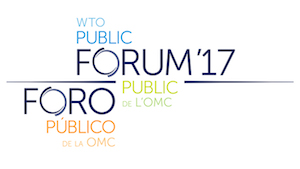Public procurement: New facts, figures and way forward for liberalized and inclusive markets
28 Sep 2017 17:00h - 18:30h
Event report
[Read more session reports from WTO Public Forum 2017]
In this working session, sponsored by the European Bank for Reconstruction and Development (EBRD), speakers contributed to the question of how e-public procurement can open procurement markets. Robert Anderson (Team Leader, Government Procurement and Competition Policy, WTO Secretariat), the moderator, suggested that the panel’s goal was two-fold: presenting new evidence of cross-border public procurement and identifying reliable sources in a research field where data appears scarce.
Ms Zornitsa Kutlina-Dimitrva (Senior Economist, Chief Trade Economist Unit, DG Trade, European Commission), discussed her unit’s data collection and analysis project. She emphasised the importance of evidence to inform sound policies in a context of rising protectionism. Procurement accounts for 6–25% of national GDPs; in Europe, it is 19%. Since most of it is at the national level, there is untapped potential in lower entities, such as states or municipalities. Although these numbers indicate that there are important benefits to be reaped from international procurement liberalisation, a severe lack of data has prevented this information from reaching governments. Now, efforts to create a global database are gradually solving the issue.
Mr Simon Evenett (Professor of International Trade and Economic Development, University of St. Gallen, and co-director, CEPR Programme in International Trade and Regional Economics), described a model developed to analyse the impact of accession to the Agreement on Government Procurement (GPA). Despite being designed to fit different countries, the model is particularly intended for transition economies (there is only one necessary condition, that other GPA signatories buy its exports). Thus, it was first tested in Georgia, from where the data presented originates. With this model, one can calculate Georgian savings after joining the Agreement. They amount to 0.25–0.5% of its GDP; nonetheless, recent translations of procurement notices will increase foreign companies’ participation and these numbers should rise.
Mr Julien Gourdon (Trade Policy Analyst, Development Division, Trade and Agriculture Directorate, Organization for Economic Cooperation and Development (OECD)), introduced the OECD taxonomy of trade barriers in government procurement. Seeking to ‘identify a wide range of trade-affecting measures’, it classified them between two categories: explicit and implicit. Explicit measures are further divided into:
- Market access restrictions (e.g.: to national suppliers);
- Domestic price preferences (e.g.: also favouring national suppliers);
- Offsets (e.g.: attempts to promote local development: ‘buy local’); and
- Collateral restrictive measures (affecting procurement while not targeting it).
Likewise, implicit measures also have sub-categories:
- Conduct of procurement (design of method);
- Qualification criteria (e.g.: certification or licensing criteria);
- Evaluation criteria (e.g.: technical contractual conditions);
- Review/complaint system (e.g.: challenge of tendering process/award);
- Transparency and information (e.g.: publication in accessible outlet); and
- Ethics/anticorruption system (e.g.: anti-bribery measures in procurement).
Researchers conducted a pilot exercise in 6 countries – Colombia, Chile, New Zealand, South Africa, Tunisia and India, and are now attempting to fit the taxonomy into the UNCITRAL model law.
Mr Gavin Hayman (Executive Director, Open Contracting Partnership (OCP)), defined his organisation as a ‘silo-busting collaboration between civil society, government and businesses to open up and monitor public contracting’. Economic efficiency and public pressure are two sides of the same coin, thus the importance of OCP’s Open Contracting Data Standard (OCDS), a standard designed for all stakeholders to access machine-readable data at each stage of contracting processes. Fulfilling four needs (value for money, integrity, service delivery and a level playing field for all businesses), OCDS has been adopted in 25 countries around the world. In Ukraine, savings exceeded €800 million. OCDS also increased competition and lowered corruption perception. Its openness, which provides an opportunity for interstate cooperation, can engender significant network effects.
Ms Eliza Niewiadomska (Senior Counsel, Public Procurement, Legal Transition Program, European Bank for Reconstruction and Development (EBRD)), presented the initial results from her organisation’s study on the participation of small and medium enterprises (SMEs) in liberalised procurement markets. It aimed to answer whether ‘the GPA is good for SMEs’. The initial results from three countries are positive, albeit with varied levels of success. Three barriers were identified: complexity, transparency, and capacity. Governments in Cyprus, Italy, and Ukraine had historically contributed to these barriers with ‘positively’ discriminatory policies such as setting price preferences or quotas for SMEs. However, after embracing data openness, these countries witnessed a rise in SME participation in public procurement. The best example is Ukraine, an OCDS adopter. There, SMEs constitute 80% of bidders, winning 71% of all public contracts and over 90% of high-value contracts. To Niewiadomska, this indicates that ‘they [now] trust the system’
The ensuing Q&A covered issues such as the absence of sustainability requirements in procurement initiatives, how to collect procurement data in Least Developed Countries (LDCs) and how to elicit public interest in such a technical matter.
by Guilherme Cooper Vicente
Related topics
Related event

